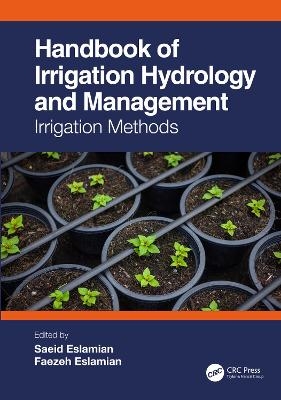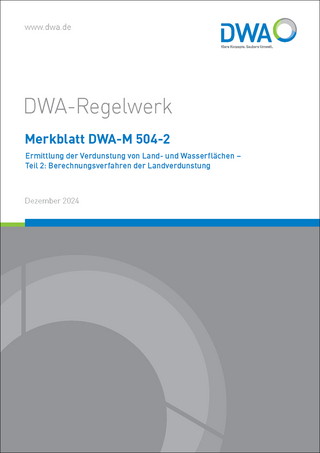
Handbook of Irrigation Hydrology and Management
CRC Press (Verlag)
978-0-367-25830-6 (ISBN)
Ever-increasing population growth has caused a proportional increased demand for water, and existing water sources are depleting day by day. Moreover, with the impact of climate change, the rates of rainfall in many regions have experienced a higher degree of variability. In many cities, government utilities have been struggling to maintain sufficient water for the residents and other users. The Handbook of Irrigation Hydrology and Management: Irrigation Methods examines and analyzes irrigated ecosystems in which water storage, applications, or drainage volumes are artificially controlled in the landscape and the spatial domain of processes varies from micrometers to tens of kilometers, while the temporal domain spans from seconds to centuries. The continuum science of irrigation hydrology includes the surface, subsurface (unsaturated and groundwater systems), atmospheric, and plant subsystems. Further, the book addresses the best practices for various types of irrigation methods including pressure, smart, surface, and subsurface, and presents solutions for water scarcity and soil salinity in irrigation.
Features:
Offers water-saving strategies to increase the judicious use of scarce water resources
Presents strategies to maximize agricultural yield per unit of water used for different regions
Compares irrigation methods to offset changing weather patterns and impacts of climate change
Dr. Saeid Eslamian is professor of Hydrology at Isfahan University of Technology, where he heads the Hydrology Research Group in the Department of Water Engineering. His research focuses mainly on statistical and environmental hydrology and climate change. In particular, he is working on modeling and prediction of natural hazards including flood, drought, storms, wind, groundwater drawdown, and pollution for arid and semi-arid zones, particularly in urban areas. He is also a Visiting Professor at Princeton University, and University of ETH Zurich, Switzerland. He has contributed to more than 300 publications in books, research journals, and technical reports or papers in conferences. He is the Founder and Editor-in-Chief of both the International Journal of Hydrology Science and Technology and the Journal of Flood Engineering. He received ASCE and EWRI awards in 2009 and 2010 for his research. Dr. Faezeh Eslamian current research focuses on the fate and transport of phosphorus through subsurface drained farmlands. Dr. Eslamian completed her PhD at McGill University, and her bachelor’s and master’s degrees in civil and environmental engineering from Isfahan University of Technology, Iran, where she evaluated natural and low-cost absorbents for the removal of pollutants such as textile dyes and heavy metals. Furthermore, she has conducted research on the worldwide water quality standards, wastewater reuse, and drought guidelines.
Part I: Solutions for Water Scarcity and Soil Salinity in Irrigation. 1. Deficit Irrigation: a Solution for Water Scarcity Conditions? 2. Irrigation Assessment: Efficiency and Uniformity. Part II: Surface Irrigation. 3. Canal Irrigation. 4. Ditch and Furrow Irrigation. 5. Level Basin Irrigation. Part III: Pressure Irrigation. 6. Sprinkler Irrigation Systems. 7. Mini-Bubbler Irrigation. 8. Measured Irrigation. Part VI: Subsurface Irrigation. 9. Qanat Irrigation Systems. 10. Subsurface Drainage/Irrigation System in Paddy Fields. 11. Picher Irrigation as a Viable Tool of Enhancing Nutrition and Livelihood of Small Scale Farmers. 12. Pot Irrigation. Part V: Smart Irrigation. 13. Automation and Smart Irrigation. 14. Intelligent Irrigation and Automation. 15. Smart Irrigation in Urban Development using Treated Wastewater Irrigation System and Management. Part VI: Water Pumps for Irrigation. 16. Water Pumps for Irrigation: an Introduction. 17. Pumps for Irrigation Systems. 18. Inverted Siphon Implementation Method in Karun River for Farm Water.
| Erscheinungsdatum | 11.07.2023 |
|---|---|
| Zusatzinfo | 39 Tables, black and white; 57 Line drawings, black and white; 193 Halftones, black and white; 250 Illustrations, black and white |
| Verlagsort | London |
| Sprache | englisch |
| Maße | 178 x 254 mm |
| Gewicht | 948 g |
| Themenwelt | Naturwissenschaften ► Geowissenschaften ► Hydrologie / Ozeanografie |
| Technik ► Bauwesen | |
| Technik ► Umwelttechnik / Biotechnologie | |
| Weitere Fachgebiete ► Land- / Forstwirtschaft / Fischerei | |
| ISBN-10 | 0-367-25830-7 / 0367258307 |
| ISBN-13 | 978-0-367-25830-6 / 9780367258306 |
| Zustand | Neuware |
| Informationen gemäß Produktsicherheitsverordnung (GPSR) | |
| Haben Sie eine Frage zum Produkt? |
aus dem Bereich


